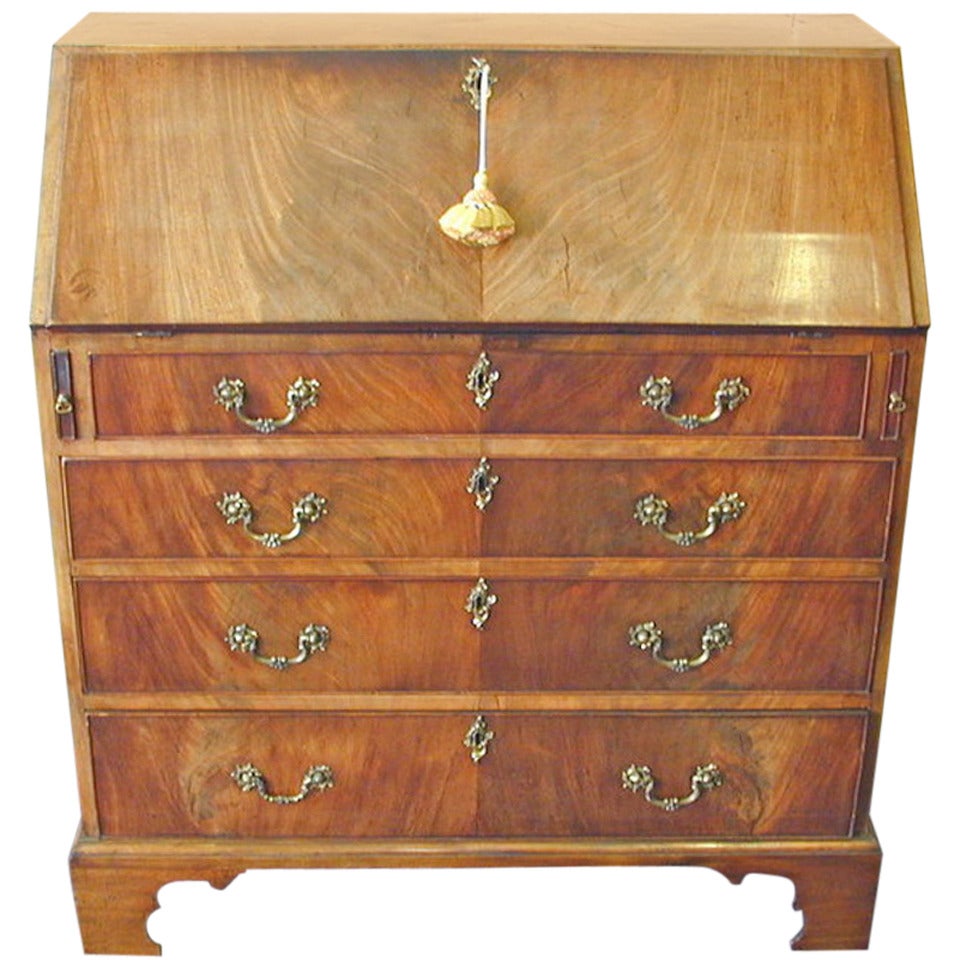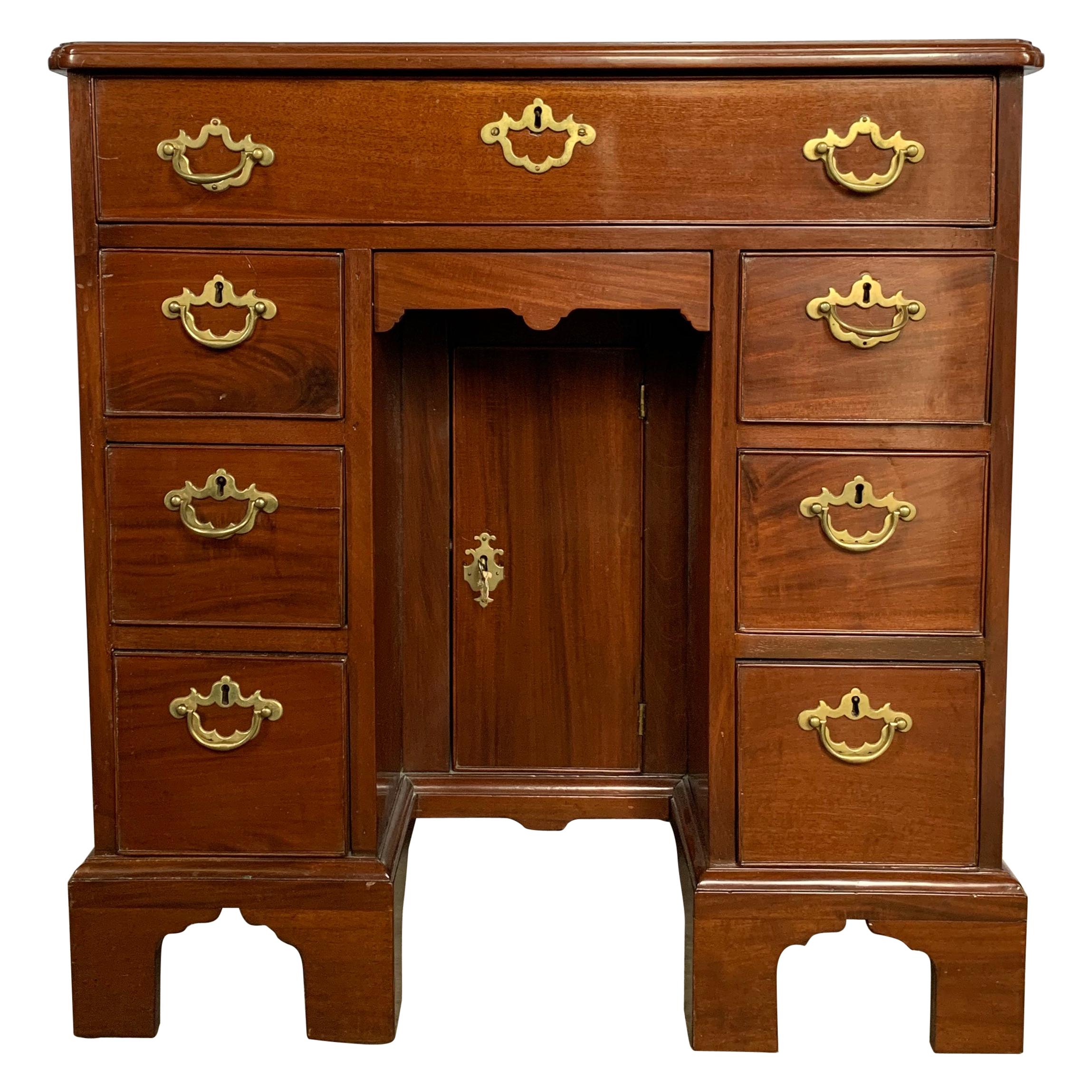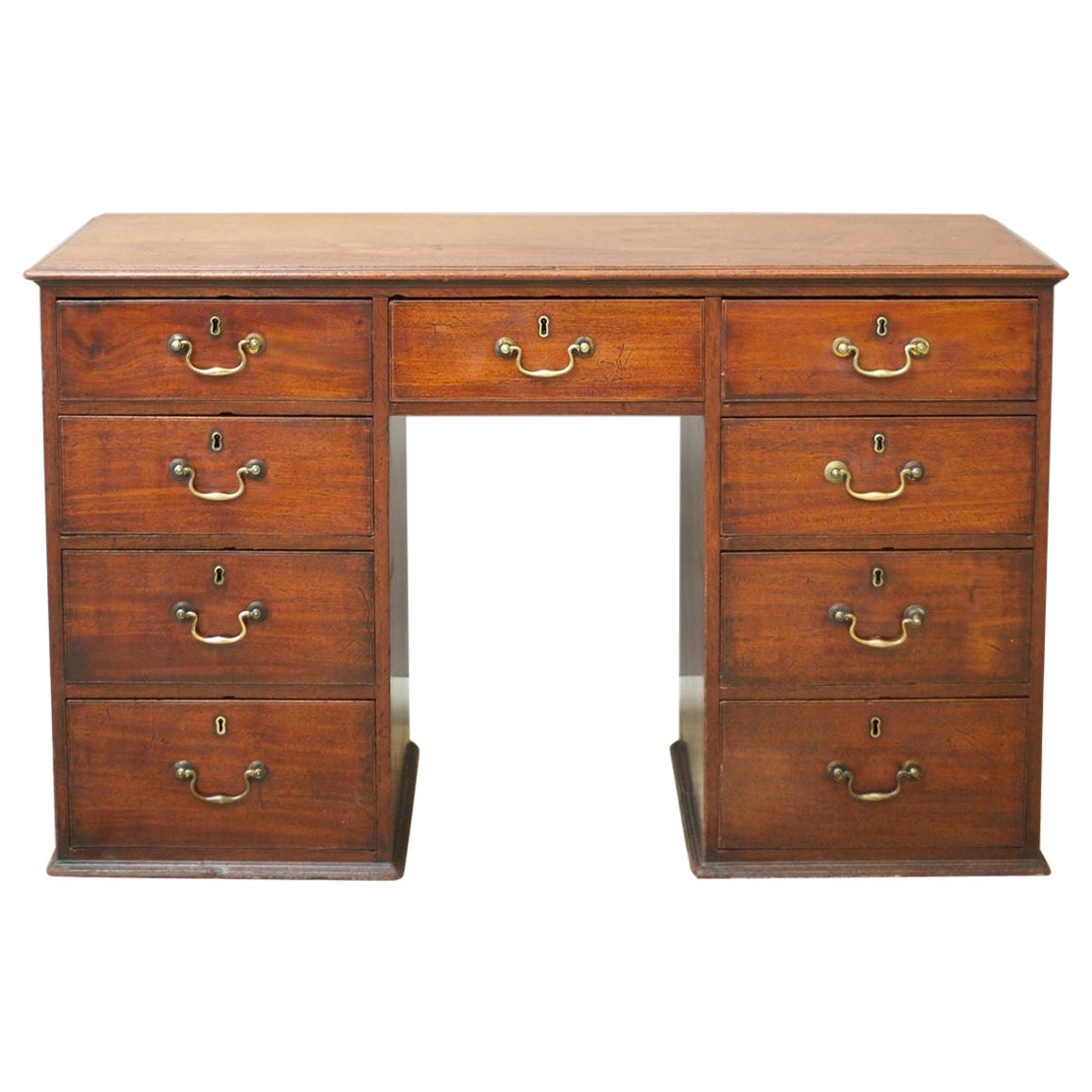Items Similar to Georgian Solid Mahogany Desk Says Knee, Late 18th Century
Want more images or videos?
Request additional images or videos from the seller
1 of 10
Georgian Solid Mahogany Desk Says Knee, Late 18th Century
About the Item
A small Georgian period mahogany knee-hole desk with blue leather sliding writing surface.
It has a single full width central drawer topped by a hinged cupboard door in the knee hole, flanked on either side by three graduated drawers on raised pedestals revealing carved bracket feet or 'hook' feet. Each drawer has a brass swivel handle and a brass keyhole with a key.
The brass hardware is original.
Period : Late 18th century.
Dimensions : height : 81 cm x length : 103 cm x depth : 58 cm.
The 18th century is the great period of splendour of English furniture, the rich and cultivated aristocracy of the Grand Tour built villas surrounded by superb gardens, acquired art collections and wished for a new furniture which followed the fashions of the time.
The cabinetmakers thus followed aesthetic developments, while maintaining a very high level of execution and refinement that contributed to the reputation of 18th century English furniture, particularly in terms of work on mahogany, of which the two greatest representatives were Thomas Chippendale (1718-1779) and Georges Hepplewhite (1727-1786), who were recognised thanks to the distribution of their model books.
The Georgian style is a term used to designate the period spanning the reigns of four rulers named George, which lasted for almost a century.
During this period, there were several styles. The first, the "early Georgian", between 1714 and 1760, established the main characteristics of 18th century furniture.
One of the great revolutions was the advent of mahogany, which replaced walnut around 1720 because of the French embargo on the export of walnut to England.
This change influenced the design and decoration of the furniture and led to the abandonment of marquetry and carved decorations: silver or gold were preferred as they were better suited to mahogany. The pieces also became lighter and more openworked, as the wood was very solid.
This was the period of the intimate alliance between interior decoration and overall interior furnishings, of which the architect William Kent was the greatest representative in the first half of the century.
- Dimensions:Height: 31.89 in (81 cm)Width: 40.56 in (103 cm)Depth: 22.84 in (58 cm)
- Materials and Techniques:
- Period:
- Date of Manufacture:18th Century
- Condition:
- Seller Location:CRÉTEIL, FR
- Reference Number:1stDibs: LU7814232793652
About the Seller
4.0
Vetted Seller
These experienced sellers undergo a comprehensive evaluation by our team of in-house experts.
1stDibs seller since 2022
9 sales on 1stDibs
Typical response time: Several days
- ShippingRetrieving quote...Ships From: CRÉTEIL, France
- Return PolicyA return for this item may be initiated within 14 days of delivery.
More From This SellerView All
- Cylinder Desk, Victorian Period, Flamed Mahogany, 19th CenturyLocated in CRÉTEIL, FRMagnificent English made cylinder desk in flamed mahogany, Victorian period. Period : 19th century Dimensions : Height : 121cm x length : 138cm x depth : 79cm It has a small support on the top to hold candles or files in progress and a large barrel-fronted desk compartment with a quality interior. Once the cylinder is opened, it reveals the interior of the desk with 10 maple veneer drawers and 6 pigeon holes to hold letters or any type of document to be sent or awaiting processing. This desk has a slide at the front which has three compartments covered with original leather allowing on each side to leave the writings in progress for the left part, the inkwell and the writing utensils for the right part and a slope of writing which can be raised for the central part. This first part rests on two pedestal bases, each composed of a series of three lockable drawers, equipped with original mahogany handles. Both bases are still equipped with their original brass castors, making the desk easy to manoeuvre. The desk is therefore divided into three individual sections, making it easy to transport and reassemble. The originality of this piece of furniture lies in its closing mechanism. A cylinder is a movable flap that folds down or up over a series of compartments and drawers, closing the top box of the desk to protect personal documents. In the early models, the cylinder consisted of a relatively fragile system of slatted curtains. This was soon replaced by a rigid quarter-circle panel...Category
Antique 19th Century English Desks and Writing Tables
MaterialsMahogany
- Illuminated Late 18th Century, Golden Frame with Gold LeafLocated in CRÉTEIL, FRSublime illumination from the end of the 18th century. It is a sonnet which was composed, drawn and written by an elderly person, since his dedication mentions his seventy-fifth year, precisely dated by the author's care in 1771. Dimensions: H: 54 x W: 42cm The frame which is original has been fully restored, then fully gilded with gold leaf, presenting a double patina. We would like to thank the HB workshop and Henda Bayoudh for the care taken in this exceptional work which has spanned more than two centuries. The sonnet is certainly the most widely used fixed form of poetry. The recipes for the sonnet vary from time to time and each poet tries to add his own personal touch. Made up of fourteen lines, originally from the Decasyllables, then especially from the Alexandrines, his lines are divided into three distinct stanzas, two quatrains followed by a sizain, separated into two tercets. Here our eyes are amazed at the agility of this elderly man, who, guided by Love, gratitude and benevolence, was able to express his gratitude, through the different arts he mastered, writing and drawing. It is a thanksgiving, not intended directly for God but for one of his disciples, who on this earth was for him like the “Savior”. We will notice the quality and the care brought to the work, the symbolism is also very present and reveals the devotion of the artist. In the lower part of the work, the presence of the dog, the dog is the animal of Ahura Mazda...Category
Antique 18th Century Drawings
MaterialsGold Leaf
- Oak Wedding Cabinet, Normandy, Period, Late 18th-Early 19th CenturyLocated in CRÉTEIL, FRImportant Norman wedding cabinet, old oak of very good quality. It consists of a straight body with straight uprights topped by a horizontal cornice. This crowning, very worked and richly decorated with a splendid medallion of sculptures in relief representing a basket of abundance, filled with roses and grapes surrounded by the two doves of Love. On each one is represented, the second part of the eighteenth fable of the book I of Jean de La Fontaine located in the first collection of the Fables of La Fontaine, published for the first time in 1668, "The Fox and the Stork", it tells us, the revenge of the Stork, which in its turn invites the Fox to her house. The Stork prepares a delicious meat, but cut in small pieces and put in a vase with a long neck, depriving the Fox of his meal. It opens on three beautiful shelves and a drawer in perfect condition. The lock and the key are also original. Period : End of 18th century - Beginning of 19th century Dimensions : Height : 230cm x Width : 148cm x Depth : 48cm It is in the 18th century that the Norman wardrobe takes its characteristic shape, it combines structure and Louis XV repertoire with Louis XVI motifs. It is at this same time of economic and social stability allowing a certain elevation of the living conditions that it enters the bourgeois and peasant residences. Today, it still symbolizes in the eyes of all marriage and creation of the new home. It was brought as a dowry by the bride along with her trousseau. The sculptures were varied. The profession or the hobby of the father of the bride...Category
Antique 19th Century Cabinets
MaterialsOak
- Louis XVI Secretaire, Waxed Polished Mahogany Veneer, 18th CenturyLocated in CRÉTEIL, FRA delightful Louis XVI secretary, built in oak and polished mahogany veneer, it is topped with a grey Saint-Anne des Pyrénées marble. It is equipped with a high drawer, offering a beautiful storage space, just below, it reveals a flap, discovering a space of a sobriety characteristic of Louis XVI Secretaries. It consists of a large niche under which are seven drawers, six of which are of identical capacity, all in mahogany veneer. The flap is covered with original Camel coloured leather. At the bottom, it is equipped with two doors, housing a new storage compartment. These three front doors are equipped with cut brass lock entries. This numerical inferiority is compensated by the presence of two pearled brass pull handles on the top drawer. The fluted uprights of this piece of furniture end in four tapered legs with gilded alloy shoes for the front legs. The back is a magnificent work of wood veneer entirely of the period. Period : 18th century Dimensions : Height : 130cm x Width : 64cm x Depth : 33cm In the 18th century, the ingenuity and talent of cabinetmakers were used to make secretaries with shapes as diverse as their names and with a great wealth of ornamentation, secretaries with a wide range of colours, and secretaries with a wide range of colours. of ornamentation, desk secretaries, of which we find in the 1760 General Inventory of Crown Furniture wonderful specimens, such as cylinder secretaries, usually made of solid mahogany, the "bonheur du jour", travelling secretaries...Category
Antique 18th Century French Directoire Secretaires
MaterialsMahogany
- Chiffonniere, Writing Table Walnut, Louis XV Style, Period : 19th CenturyLocated in CRÉTEIL, FRAdorable little writing case in walnut with inlay, Louis XV style. It has four high, slender and curved legs. Its central body is composed of a drawer pull and three rows of drawers under a top tray with wide borders surrounding the back and sides, thus preventing objects from falling out. The pull-out is covered with green felt. Each drawer opens with small round pull knobs. The front and sides are covered with diagonal marquetry. Period: 19th century. Dimensions : Height : 69cm x width : 21 x depth : 21cm. The Louis XV style covers a period from 1725 to 1760, a new and precious style, it is also called Rocaille style because the rocaille remains the preferred ornament, it is also called Rococo style or Pompadour style. The distinction is made during this period between the furniture of apparat and the usual furniture, it is also the great time of the cabinetmakers, of the floral or geometrical marquetries, of the taste for the exoticism and of the arrival of a number of small pieces of furniture related to the need for comfort, like the secretaries, the dusters, the bedside tables, etc. Louis XV furniture is a must in the history of decorative arts! It is referred to as "the moment of perfection of French art". Even today, while furniture is essentially based on straight lines and parallelepipedal volumes, the curved Louis...Category
Antique 19th Century Louis XV Desks and Writing Tables
MaterialsWalnut
- Mahogany Writing Table - Bean Shape - Edwardian Period - Circa: 1890-1900Located in CRÉTEIL, FRA delightful antique writing table in mahogany, in the form of a "bean" or "kidney", in the full Edwardian period. This magnificent piece, entirely restored by our workshops, has a f...Category
Antique 19th Century British Country Desks and Writing Tables
MaterialsMahogany
You May Also Like
- Rare 18th Century Georgian Period Mahogany Architect DeskLocated in Chicago, ILThis rare and elegant Georgian Architect’s desk has a ratchet top, extending drawer front, as well as storage compartments. Architect desks, m...Category
Antique 18th Century English Georgian Desks and Writing Tables
MaterialsBrass
- 18th century walnut knee Hole deskLocated in Penzance, GBThis is a really nice 18th century figured walnut Knee Hole desk .This desk has oak linings, cock beaded drawers and is sitting on bracket feet ,the veneer is well figured and is a good colour .The top has a two piece mirrored...Category
Antique Early 18th Century English Desks and Writing Tables
MaterialsWalnut
- 18th Century Mahogany DeskLocated in Lincolnshire, GBA George III period mahogany kneehole desk of good size, with the original brasses and lovely one piece top. The whole piece is of great colour and patina, circa 1780 This desk is...Category
Antique 1780s English George III Desks and Writing Tables
MaterialsBrass
- Georgian 18th Century Mahogany BureauLocated in Bedfordshire, GBAn 18th Century Georgian Mahogany Bureau Having Well Figured Fall Flap Above Four Long Drawers With Original Water Gilt Handles Raised On Original Bracket Feet (Typical of the lat...Category
Antique Mid-18th Century English Georgian Desks and Writing Tables
MaterialsMahogany
- Mid-19th Century Georgian Style Mahogany Knee Hole DeskLocated in Stamford, CTMid-19th century Georgian style mahogany knee hole desk in very nice original condition. The case having a single top drawer with a knee hole center flanked by three by three drawers...Category
Antique Late 19th Century Georgian Desks and Writing Tables
MaterialsMahogany
- Georgian Solid Mahogany DeskLocated in Malton, GBThis is a simple very well made Georgian desk. Made from solid mahogany and as far as I can tell totally original. The drawers all run smooth and close flush. The overall condition i...Category
Antique Late 18th Century Desks and Writing Tables
MaterialsMahogany
Recently Viewed
View AllMore Ways To Browse
18th Century Mahogany Tables
18th Century Brass Table
Small Mahogany And Brass Table
Small Period Desks
French One Drawer Desk
Antique Desk Collections
Gold Brass Table Desk
Antique Three Drawer Writing Desk
Two Pedestal Desks
Knee Hole
Writing Cupboard
Mahogany George Desk
Small Antique Mahogany Desk
Antique Solid Mahogany Side Table
Antique Style Walnut Desk
New Small Desk
Antique Georgian Desk
Antique Style Mahogany Writing Desk





